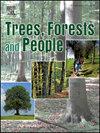Treeline structure and regeneration pattern in protected and non-protected areas, Indian western Himalaya
IF 2.7
Q1 FORESTRY
引用次数: 0
Abstract
Treeline ecotone in the Himalayan region is a relevant ecological indicator of environmental perturbations and anthropogenic disturbances. Given this, six representative sites (3 each in protected and non-protected areas) were selected for assessing forest dynamics and anthropogenic disturbances in treeline ecotone in the western Himalaya. The study reveals that treelines under protected areas show higher species richness (27) and species diversity (3.42) compared to species richness (17) and species diversity (2.22) in the non-protected areas. The average TBA of tree species was higher (36) at protected sites compared to 27 in the non-protected sites. Further, the average density of seedlings (7587) and saplings (633) was higher in protected sites than in non-protected sites (seedlings-1720 & 263-saplings). Thus, the better regeneration of dominant tree species with an expanding population structure in the protected area. This showed the efficient role of protected sites in biodiversity conservation and management. Livestock grazing and fuelwood harvesting were the key human-induced pressures in the non-protected sites. Fuelwood consumption was recorded as a maximum (5.4 kg/capita/day) for Kuti village (3800 m) in the Byans Valley, followed by Sipu (3.4) in Darma Valley and a minimum for Martoli (2.4) in Johar Valley. Anthropogenic disturbances have impacted the regeneration and recruitment of tree species in treeline ecotone in the non-protected sites. An increasing number of seedlings and saplings was observed in an open canopy of treeline ecotone, which indicates an expanding number of seedlings and saplings was observed in the open canopy treeline ecotone, which suggests the possibility of expansion of tree species towards higher elevations. Long-term ecological monitoring and observation are suggested to understand better spatial and temporal changes in treeline ecotone considering climate change and anthropogenic disturbances.
印度西喜马拉雅保护地与非保护地树线结构与更新格局
喜马拉雅地区树线过渡带是环境扰动和人为干扰的相关生态指标。有鉴于此,本文选择了6个具有代表性的地点(保护区和非保护区各3个)来评估西喜马拉雅树线过渡带的森林动态和人为干扰。研究表明,保护区林线的物种丰富度(27)和物种多样性(3.42)高于非保护区的物种丰富度(17)和物种多样性(2.22)。保护地树种的平均TBA为36,高于非保护地的27。此外,保护地的平均幼苗密度为7587株,树苗密度为633株,高于非保护地(幼苗密度为1720株,树苗密度为1720株;263 -树苗)。因此,随着种群结构的扩大,保护区内优势树种的更新效果较好。这表明了保护区在生物多样性保护和管理中的有效作用。放牧牲畜和采伐薪柴是非保护区主要的人为压力。Byans山谷的Kuti村(3800米)的薪材消耗最高(5.4公斤/人/天),其次是Darma山谷的Sipu村(3.4公斤/人/天),Johar山谷的Martoli村最低(2.4公斤/人/天)。人为干扰影响了非保护地林带树种的更新和补充。开放林冠带树苗和树苗数量呈增加趋势,表明开放林冠带树苗和树苗数量呈增加趋势,表明树种向高海拔扩展的可能性。建议通过长期的生态监测和观测,更好地了解考虑气候变化和人为干扰的树线交错带的时空变化。
本文章由计算机程序翻译,如有差异,请以英文原文为准。
求助全文
约1分钟内获得全文
求助全文
来源期刊

Trees, Forests and People
Economics, Econometrics and Finance-Economics, Econometrics and Finance (miscellaneous)
CiteScore
4.30
自引率
7.40%
发文量
172
审稿时长
56 days
 求助内容:
求助内容: 应助结果提醒方式:
应助结果提醒方式:


